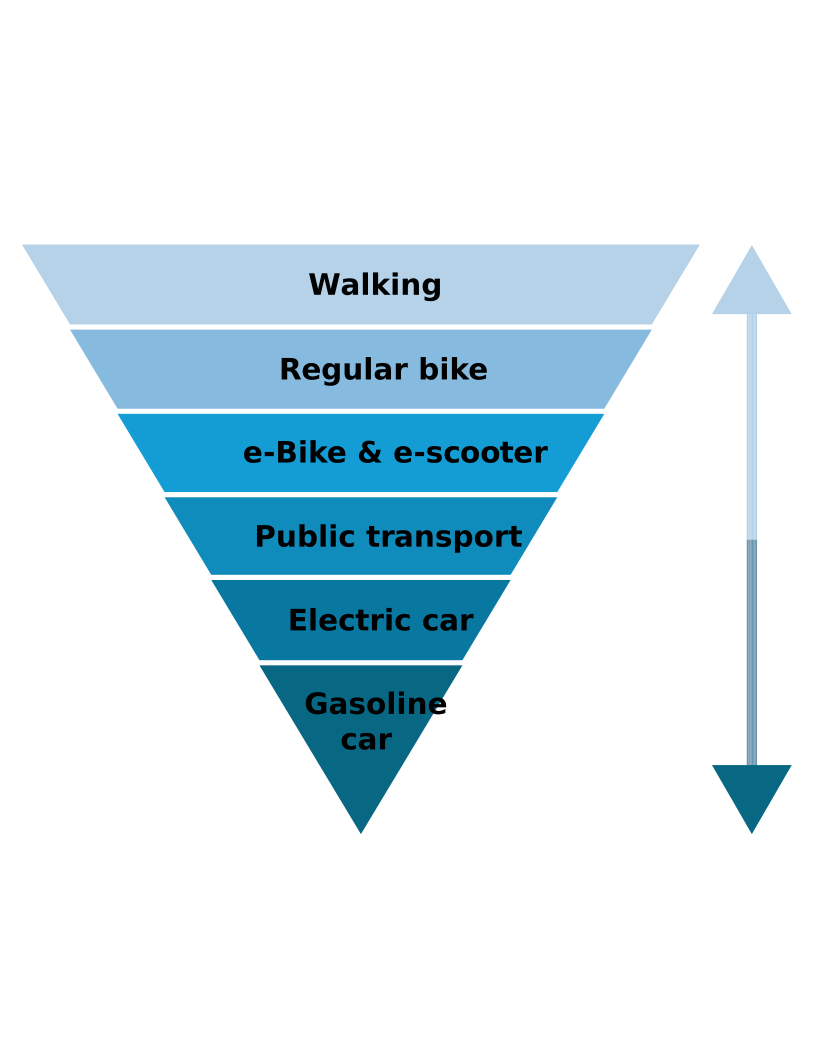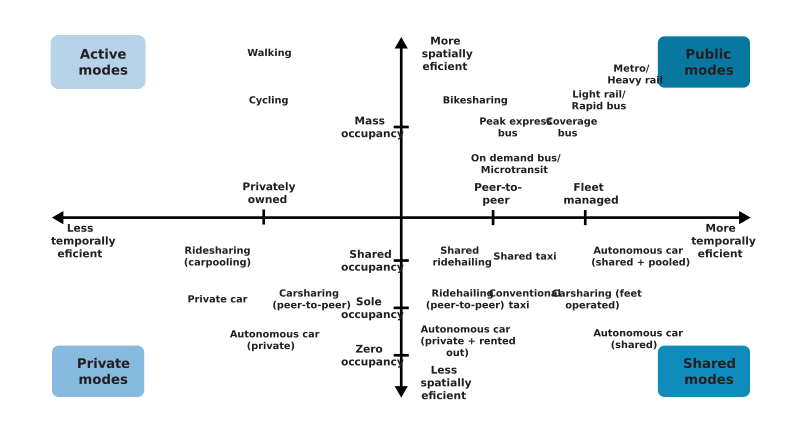Rethinking Urban Mobility, can MaaS Drive a Sustainable Modal Shift?
Editie: 32 - Inner City Restructuring
Published on: 12 juni 2025
In recent decades, urbanisation has steadily increased worldwide, a trend expected to continue well into the future. With the rising urban population come significant challenges for governments and municipalities as they work to ensure liveable cities both now and for future generations. Key priorities include providing adequate housing, sufficient public facilities and, crucially, a sustainable and efficient transportation network.
The growing demand for inner-city transportation is straining urban transport systems, which are more often than not heavily car-dependent and major contributors to congestion and environmental issues (Gwilliam et al., 2004). Already, the transport sector accounts for 24% of global greenhouse gas emissions, with projections suggesting a potential doubling by the year 2050, if effective measures are not implemented (Zhang et al., 2018).
To prevent urban transportation networks from becoming overwhelmed and keep cities liveable, change is essential. Strategies aimed at reducing private car usage and promoting sustainable, active modes are gaining traction (Cullinane & Cullinane, 2003). A notable strategy in this context, gaining popularity, is Mobility-as-a-Service (MaaS). The question remains however: Can MaaS truly deliver on its promise to make urban transportation more sustainable?
What is MaaS?
MaaS is a digital platform that integrates multiple transport options, such as public transit, bike-sharing, car-sharing, and ride-hailing, into a single, user-friendly system that streamlines urban mobilities. (Kamargianni & Goulding, 2018). By allowing travelers to plan, book, and pay for multi-modal journeys through one app, MaaS reduces reliance on private cars while enhancing accessibility and convenience. A key feature of MaaS is its ability to offer real-time travel updates, flexible payment options, and personalized transport solutions tailored to individual needs. Public transit remains the backbone of MaaS, but shared mobility services, such as e-scooters and car-sharing, help bridge transit gaps and improve first- and last-mile connectivity (Matyas, 2020). MaaS platforms can also include additional services, like parking support or onboard entertainment, to further enrich the travel experience. The level of MaaS integration can vary, from basic real-time travel information to fully integrated mobility bundles that promote sustainable, car-free lifestyles. As cities seek smarter and greener transport solutions, MaaS has the potential to transform urban mobility by fostering collaboration between governments, transport providers, and technology developers.

Figure 1: Green Transportation Hierarchy
Sustainability in Transportation
As cities worldwide undergo redevelopment to meet sustainability goals, rethinking urban transport is essential. The way people move th
rough cities significantly impacts air quality, congestion, and overall livability. Understanding the sustainability of different transport modes is crucial in shaping future urban spaces.
A widely recognized model in academic literature, the Green Transportation Hierarchy (Bergman, 2020), originally developed by Bradshaw (1992), ranks transportation options based on environmental impact. At the top are walking and cycling, followed by electric bikes, scooters, and public transit. Private cars, particularly gasoline-powered ones, rank the lowest due to their high emissions and low occupancy rates. While this model effectively highlights environmental concerns, it overlooks economic and social factors such as affordability and accessibility.
A complementary approach, the Modal Efficiency Framework (Hensher et al., 2020b), adds another dimension by evaluating spatial and temporal efficiency. In dense urban areas, where road space is limited, public transit and active travel modes emerge as the most efficient, while private cars rank lowest due to high idle times and space consumption. Although car-sharing and ride-hailing still rely on cars, their increased utilization makes them more sustainable than private vehicle ownership.

Figure 2: Modal Efficiency Framework
By encouraging shifts toward more sustainable travel behaviour, MaaS aligns with broader transportation goals of reducing environmental impact and increasing the availability of alternatives to the private car. However, the extent to which MaaS will drive behavioural change remains uncertain, requiring further research to assess its real-world impact. MaaS is often presented as a revolutionary solution for urban mobility, by reducing private car ownership and encouraging more sustainable transport choices. However, despite its appeal, some researchers argue that its benefits remain largely theoretical, as real-world implementations are still few and in early stages (Alyavina et al., 2022). Critics highlight challenges such as cooperation between transport providers, data privacy concerns, and the risk that MaaS might compete with, rather than complement, public transit. Some studies suggest that ride-hailing and micro-mobility services, key components of MaaS, could divert users away from buses and trains, while e-scooters where often found to replace walking trips rather than reducing car use (Sanders et al., 2020). The effectiveness of MaaS appears to be highly context-dependent, influenced by local infrastructure, regulations, and mobility patterns. To fulfil its sustainability potential, MaaS must be carefully integrated into existing transport networks, backed by strong public policies, and assessed through long-term behavioural studies. While MaaS holds promise, its success with enhancing rather than disrupting sustainable urban mobility, depends on evidence-based implementation instead of optimistic assumptions about its possibilities.
Sustainability of MaaS usage
This study aimed to contribute to a better understanding of the substitution effects between various transport modes in the context of MaaS availability, with a particular focus on the environmental consequences of the preference of one mode over another. To achieve this an experiment was created in which participants were presented with a hypothetical scenario wherein they had subscribed to a level 4 MaaS service. This is a MaaS service in which societal goals and incentives are integrated (Sochor et al., 2018). In the experiment a distinction was made between conventional active and public modes (walking, cycling, public transit) and motorised shared modes (shared e-bike and e-scooter, car-sharing, ride-hailing) available within a MaaS subscription. A modal shift away from the former towards the MaaS modes could be considered a less sustainable transport choice, which goes against the societal goals underlying the MaaS service regarding improving sustainability in the transport sector. The private car was deliberately excluded from this study, in an effort to only investigate the impact of MaaS on conventional active and public modes.
An additional point of interest in this study was the inclusion of strategies to guide behaviour during the decision-making processes for mode choice, which is an integral part of a level 4 MaaS service. Two types of interventions were identified: a monetary incentive and an information nudge aimed at increasing awareness surrounding the environmental impact of mode choices. If proven effective, such methods can be used as an integral tool for MaaS services in guiding desired behaviour of travellers, in accordance with societal goals.
Conclusion
The study findings, resulting from the stated choice experiment and subsequent analysis, indicate that the availability of MaaS options influences travel behaviour to some extent, with conventional public transit users being more likely to adopt MaaS alternatives, particularly when offered similar public transit services at a discounted rate. However, users of private active modes showed less inclination to switch, which is a positive outcome for sustainability. A key concern is the potential for MaaS to substitute conventional public transit rather than private car use, which could undermine its sustainability goals. Encouragingly, shifts from active and public transit to motorized MaaS modes were minimal, likely due to participants’ environmental awareness, higher travel costs, and lower income levels. Overall, the specific set of MaaS alternatives studied had a limited impact on sustainability, as most users either maintained their current transport choices or switched to equally sustainable options. To maximize MaaS’s positive influence, financial incentives should be integrated into service design, as they have proven effective in shaping travel behaviour. Information nudging only showed minimal impact on mode choice, yet visualising travel information, like vehicle emissions, did show potential for guiding sustainable travel behaviour and would be worth investigating further. As an additional check for the exclusion of the private car participants were asked to indicate a willingness to pay to continued use of this mode in the research scenario. Findings showed an overall high willingness to pay for this possibility. Furthermore, this group of participants showed a high preference for car-based modes available within MaaS. This highlights a notable risk for real-world applications of MaaS where users of the private car are not prepared to embrace MaaS as an alternative for their private car. For MaaS to be truly successful, the behaviour and mode preferences of this group will have to be actively altered, for which different forms of interventions could prove very useful.
About the author: Ir. K.L.W. Verspaij
|
Koen Verspaij graduated from Eindhoven University of Technology in June of 2024, completing his Master’s degree in Architecture, Building, and Planning with a specialisation in Urban Systems and Real Estate. In October of that same year Koen started working as a junior consultant at the management and consulting firm Brink.
|
 |
References
Alyavina, E., Nikitas, A., & Njoya, E. T. (2022). Mobility as a service (maas): A thematic map of challenges and opportunities. Research in Transportation Business & Management, 43, 100783. doi: 10.1016/ j.rtbm.2022.100783
Bergman, Z. W. (2020). Mobility as agency: Perspectives from south africa, china, and the united states (Unpublished doctoral dissertation). University of the Witwatersrand, Faculty of Humanities, School of Human and Community Development.
Bradshaw, C. (1992). The green transportation hierarchy: A guide for personal and public decisionmaking.
Cullinane, S., & Cullinane, K. (2003). Car dependence in a public transport dominated city: evidence from hong kong. Transportation research part D: Transport and environment, 8(2), 129–138. doi: 10.1016/S1361-9209(02)00037-8
Gwilliam, K., Kojima, M., & Johnson, T. (2004). Reducing air pollution from urban transport. World Bank Washington, DC.
Hensher, D., Ho, C. Q., & Wong, Y. Z. (2020b). What is MaaS and how it fits into the transport landscape. In Understanding mobility-as-a-service (pp. 13–33). Elsevier.
Kamargianni, M., & Goulding, R. (2018). The Mobility as a Service Maturity Index: Preparing the Cities for the Mobility as a Service Era [Article]. 7th Transport Research Arena TRA, 17 – 21. (Cited by: 7) doi: 10.5281/zenodo.1485002
Matyas, M. (2020). Opportunities and barriers to multimodal cities: Lessons learned from in-depth interviews about attitudes towards mobility as a service. European Transport Research Review, 12(1), 1–11. doi: 10.1186/s12544-020-0395-z
Sanders, R. L., Branion-Calles, M., & Nelson, T. A. (2020). To scoot or not to scoot: Findings from a recent survey about the benefits and barriers of using e-scooters for riders and non-riders. Transportation Research Part A: Policy and Practice, 139, 217–227. doi: 10.1016/j.tra.2020.07.009
Sochor, J., Arby, H., Karlsson, I. M., & Sarasini, S. (2018). A topological approach to mobility as a service: A proposed tool for understanding requirements and effects, and for aiding the integration of societal goals. Research in Transportation Business & Management, 27, 3–14. doi: 10.1016/j.rtbm.2018.12.003
Zhang, R., Fujimori, S., Dai, H., & Hanaoka, T. (2018). Contribution of the transport sector to climate change mitigation: Insights from a global passenger transport model coupled with a computable general equilibrium model. Applied energy, 211, 76–88. doi: 10.1016/j.apenergy.2017.10.103
Mail the editors